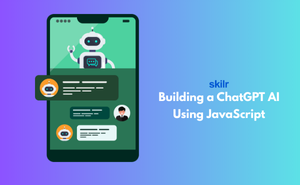👇 CELEBRATE CLOUD SECURITY DAY 👇
00
HOURS
00
MINUTES
00
SECONDS

The ChatGPT AI with JavaScript certification focuses on helping learners create smart conversational systems using AI technology. ChatGPT can generate responses just like a human, while JavaScript acts as the backbone to build and run these AI-powered chat interfaces on websites or apps.
Through this program, learners will gain practical experience in connecting ChatGPT with front-end and back-end systems, managing user requests, and customizing AI interactions. This skill is highly valuable as businesses and apps increasingly adopt AI chatbots for customer support, online learning, and productivity tools.
This exam is ideal for:
Industry-endorsed certificates to strengthen your career profile.
Start learning immediately with digital materials, no delays.
Practice until you’re fully confident, at no additional charge.
Study anytime, anywhere, on laptop, tablet, or smartphone.
Courses and practice exams developed by qualified professionals.
Support available round the clock whenever you need help.
Easy-to-follow content with practice exams and assessments.
Join a global community of professionals advancing their skills.
Yes, it explains connecting APIs to backend systems for more advanced setups.
Yes, by integrating it into mobile frameworks like React Native.
Absolutely, chatbot development is in high demand among businesses.
Customer support bots, personal assistants, educational tools, and fun interactive bots.
Basic coding experience is required to understand JavaScript and API usage.
Web-based chat interfaces with chat bubbles, forms, and interactive elements.
ChatGPT is an AI that can have human-like conversations.
JavaScript is widely used in web development, making it easy to integrate AI into websites.
No, the focus is on using ChatGPT with JavaScript, not building AI models.
Yes, as long as they know basic JavaScript and web development concepts.